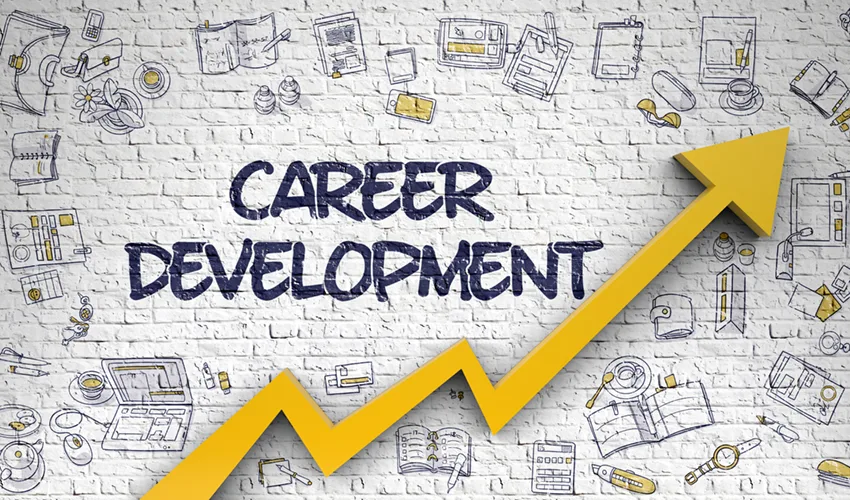Career Development: Pathways to Promotion

In today’s dynamic work environment, career development is more important than ever. Employees are increasingly looking for meaningful growth opportunities and clear pathways to promotion. For companies, fostering career development is not only a way to retain top talent but also to build a more skilled and motivated workforce. In this blog, we’ll explore strategies employees can use to navigate their career paths and the critical role HR plays in supporting their growth and development.
1. Self-Assessment: Understanding Your Strengths and Weaknesses
The first step in career development is self-assessment. Employees should take the time to reflect on their strengths, weaknesses, interests, and career goals. Tools such as SWOT analysis (Strengths, Weaknesses, Opportunities, Threats) can help in this process. Understanding personal competencies and areas for improvement allows employees to create a targeted career development plan.
2. Setting SMART Goals
Once self-assessment is complete, the next step is to set SMART (Specific, Measurable, Achievable, Relevant, Time-bound) goals. Clear and realistic goals provide direction and a sense of purpose. For example, if an employee aims to become a team leader, they might set goals to improve their leadership skills, complete relevant training programs, and gain experience in project management.
3. Seeking Feedback and Mentorship
Constructive feedback is invaluable for career development. Employees should actively seek feedback from peers, supervisors, and mentors. Mentorship, in particular, can provide guidance, support, and insight into potential career paths. A mentor can help identify strengths, suggest areas for development, and offer advice on navigating the corporate landscape.
4. Continuous Learning and Skill Development
The importance of continuous learning cannot be overstated. The workplace is constantly evolving, and staying relevant requires an ongoing commitment to learning. Employees should take advantage of training programs, online courses, workshops, and certifications to enhance their skills. Developing both hard skills (technical abilities) and soft skills (communication, leadership) is crucial for career advancement.
5. Building a Professional Network
Networking is a powerful tool for career development. Building relationships with colleagues, industry professionals, and influencers can open doors to new opportunities and provide support and advice. Attending industry conferences, joining professional organizations, and participating in networking events are excellent ways to expand one’s professional network.
6. Demonstrating Initiative and Leadership
Taking initiative and demonstrating leadership qualities can significantly impact career progression. Employees should look for opportunities to lead projects, volunteer for challenging assignments, and propose innovative solutions. Being proactive and showing a willingness to go above and beyond can set an employee apart and highlight their potential for promotion.
The Role of HR in Career Development
HR plays a pivotal role in supporting employees’ career development and creating pathways to promotion. Here are several ways HR can facilitate this process:
1. Career Development Programs
HR can design and implement comprehensive career development programs that include training, mentoring, and coaching. These programs should be tailored to meet the needs of employees at different stages of their careers and provide clear pathways for advancement.
2. Performance Management Systems
Effective performance management systems are essential for career development. Regular performance reviews, goal setting, and feedback sessions help employees understand their progress and areas for improvement. HR can ensure that performance appraisals are fair, consistent, and aligned with career development objectives.
3. Learning and Development Opportunities
HR should provide access to a wide range of learning and development opportunities. This includes in-house training sessions, external workshops, online courses, and tuition reimbursement programs. Encouraging a culture of continuous learning helps employees acquire new skills and stay competitive.
4. Succession Planning
Succession planning is a strategic HR function that identifies and develops future leaders within the organization. By recognizing high-potential employees and providing them with the necessary training and experiences, HR ensures a steady pipeline of talent ready to step into key roles as they become available.
5. Career Pathing Tools
HR can develop career pathing tools that outline potential career trajectories within the organization. These tools provide employees with a clear understanding of the skills, experiences, and qualifications required for various roles, helping them plan their career progression accordingly.
6. Employee Engagement and Retention Strategies
Engaged employees are more likely to invest in their career development and stay with the organization. HR should implement engagement and retention strategies that include recognition programs, work-life balance initiatives, and opportunities for career growth. A supportive and motivating work environment is key to retaining top talent and fostering their development.
Conclusion
Career development is a shared responsibility between employees and HR. By taking proactive steps such as self-assessment, goal setting, continuous learning, and networking, employees can navigate their career paths effectively. Simultaneously, HR can support this journey by providing robust career development programs, performance management systems, and learning opportunities. Together, these efforts create a thriving workplace where employees are empowered to grow, develop, and achieve their career aspirations.






Responses